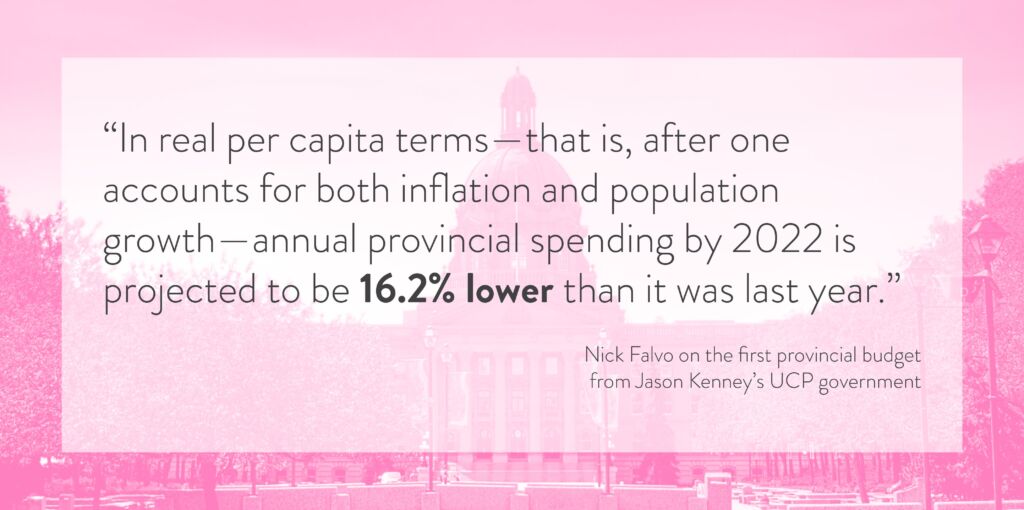On October 24 (halfway through the fiscal year) Alberta finance minister Travis Toews tabled the 2019-20 Alberta budget. The first provincial budget of Jason Kenney’s UCP government, it announced substantial spending cuts—specifically, a 2.8% reduction in nominal spending by 2022 (or 0.7% per year on average between now and then). In real per capita terms—i.e., after one accounts for both inflation and population growth—annual provincial spending by 2022 is projected to be 16.2% lower than it was last year.
Here are 10 other things to know about the budget:
- Alberta’s public sector will be reduced by approximately 7.7%. There will be an anticipated loss of more than 16,000 public sector jobs over the next four years through a combination of layoffs and attrition. Five days after the budget, the Government also announced its intent to ask for ‘wage rollbacks’ from public sector workers.
- There will be substantial cuts to Alberta’s health sector. Healthcare spending will grow by just 1% annually in nominal terms over the next four years—which amounts to a substantial cut in real terms, in light of anticipated population growth and inflation. It had been rising by 3% annually in recent years, due largely to population increases and an aging population. (The good news is that the budget did commit $100 million in new funding for a mental health and addictions strategy.)
- K-12 education funding is being frozen at $8.2 billion until 2022, even though enrolment is projected to increase by 2.2% each year between now and then. This will likely lead to some combination of larger student-teacher ratios, layoffs, salary reductions and deferred facility maintenance. The good news is that there will be a 20% funding increase for a school nutrition program that feeds more than 30,000 students one meal per day. This amounts to a total of $5 million.¹ However, one should keep in mind that there are more than 700,000 K-12 students currently enrolled in Alberta schools.
- Tuition fees are going up, and operating funding for colleges and universities is going down. Tuition fees for post-secondary students are expected to increase by up to 7% annually over the next four years, ending the tuition freeze brought in by Rachel Notley’s NDP government. Also, interest rates on student loans are increasing from prime to prime plus 1%. (It’s important to note that Alberta students already have the highest student debt in Canada.) For the current fiscal year, operating funding for post-secondary institutions will decrease by between 0% to 8%. And by 2022-23, provincial funding for operating budgets may see a decrease of a much greater magnitude—possibly as much as 20-25% lower than last year in nominal terms (that’s without taking into account rising enrolment or inflation). According to Alex Usher: “That would make these the single largest set of cuts to Canadian institutions since the Depression.”
- Various income assistance programs for low-income households will no longer be indexed to inflation. This applies to:
- the Assured Income for the Severely Handicapped;
- the Alberta Seniors Benefit;
- Income Support;
- Special Needs Assistance for Seniors;
- the Supplementary Accommodations Benefit;
- and the Seniors Lodge Assistance program.
- The Alberta Family Employment Tax Credit and the Alberta Child Benefit have been merged into a single program. It will be called the Alberta Child and Family Benefit (ACFB) and will launch in July 2020. The lowest-income families will get more than previously, but most families will get less. Indeed, the new benefit will deliver approximately $40 million less to Alberta families than the two previous benefits were providing. The ACFB will be non-taxable and won’t affect eligibility for other benefit programs.
- Early childhood education is seeing a cut of nearly 13%. Childcare and Child Intervention Funding for early intervention programs will be reduced to $91 million in the 2020-21 compared to $104 million this year. Child intervention funding will then be frozen for the next three years—i.e., no adjustment for caseload growth or inflation.
- Some housing cuts were announced. Starting next year, operating budgets for Housing Management Bodies (HMBs) will be reduced by an average of 3.5% (for a detailed overview of HMBs, see this webinar). There will also be a 24% reduction to the Rental Assistance program, which provides financial assistance for low- to moderate-income households to assist with monthly rent payments for up to one year. This 24% reduction begins in 2020 and takes full effect within three years. There is concern about the future of the Indigenous Housing Capital Program, a program that seeks to increase the supply of affordable housing to Alberta’s Indigenous communities.
- Municipalities were dealt a serious blow. For the upcoming fiscal year, the Ministry of Municipal Affairs budget will see a 9% cut. What’s more, the budget announced that the provincial government will terminate the City Charters deal with Edmonton and Calgary, a move that appeared to catch the Mayor of Edmonton by surprise. The budget may also result in delays to light rail transit projects in both Calgary and Edmonton.
- Albertans will see some very modest tax increases. Albertans will collectively pay more in personal income taxes due to exemptions and tax brackets no longer being indexed to inflation (background on this is available here). Property taxes will likely see a very slight increase as well (this is discussed here).
¹ More information on this program can be found here.
Nick Falvo is a Calgary-based research consultant, a research associate at the Carleton University Centre for Community Innovation, and a CCPA research associate. Follow him on twitter at @nicholas_falvo.
I wish to thank the following individuals for assistance with this blog post: Tony Clark, Fiona Clement, Kelly Dowdell, Susan Falvo, Chris Gallaway, Neil Hepburn, Nevena Ivanovic, Jonn Kmech, John Kolkman, Susan McGee, Kevin McNichol, Courtney Mo, Richard Mueller, Alejandro Pachon, Barb Silva, Garry Sran, Jonathan Teghtmeyer, Trevor Tombe, Alex Usher, Barret Weber, Sarah Woodgate, Trevor Zimmerman, and one anonymous source. Any errors are mine.







